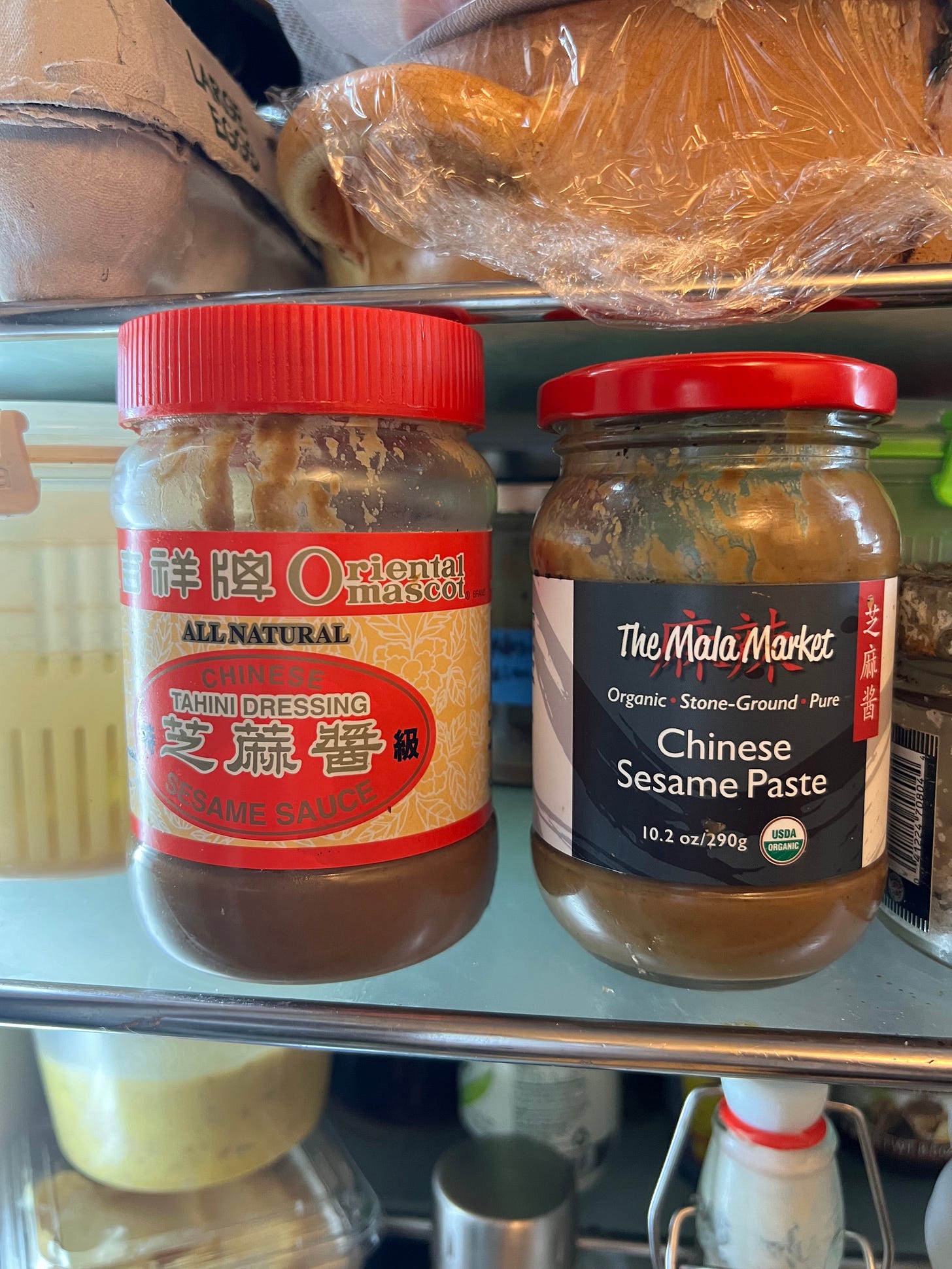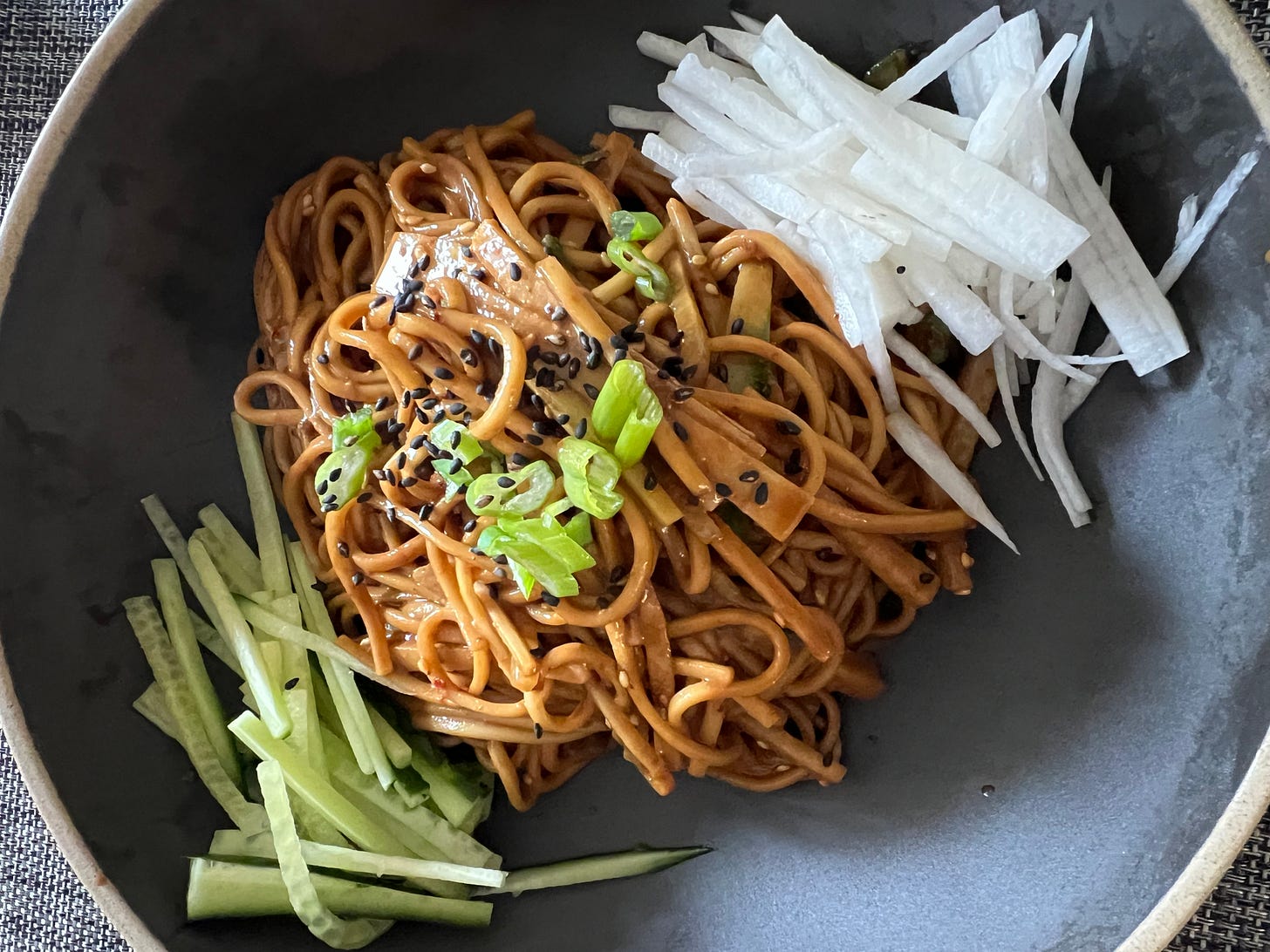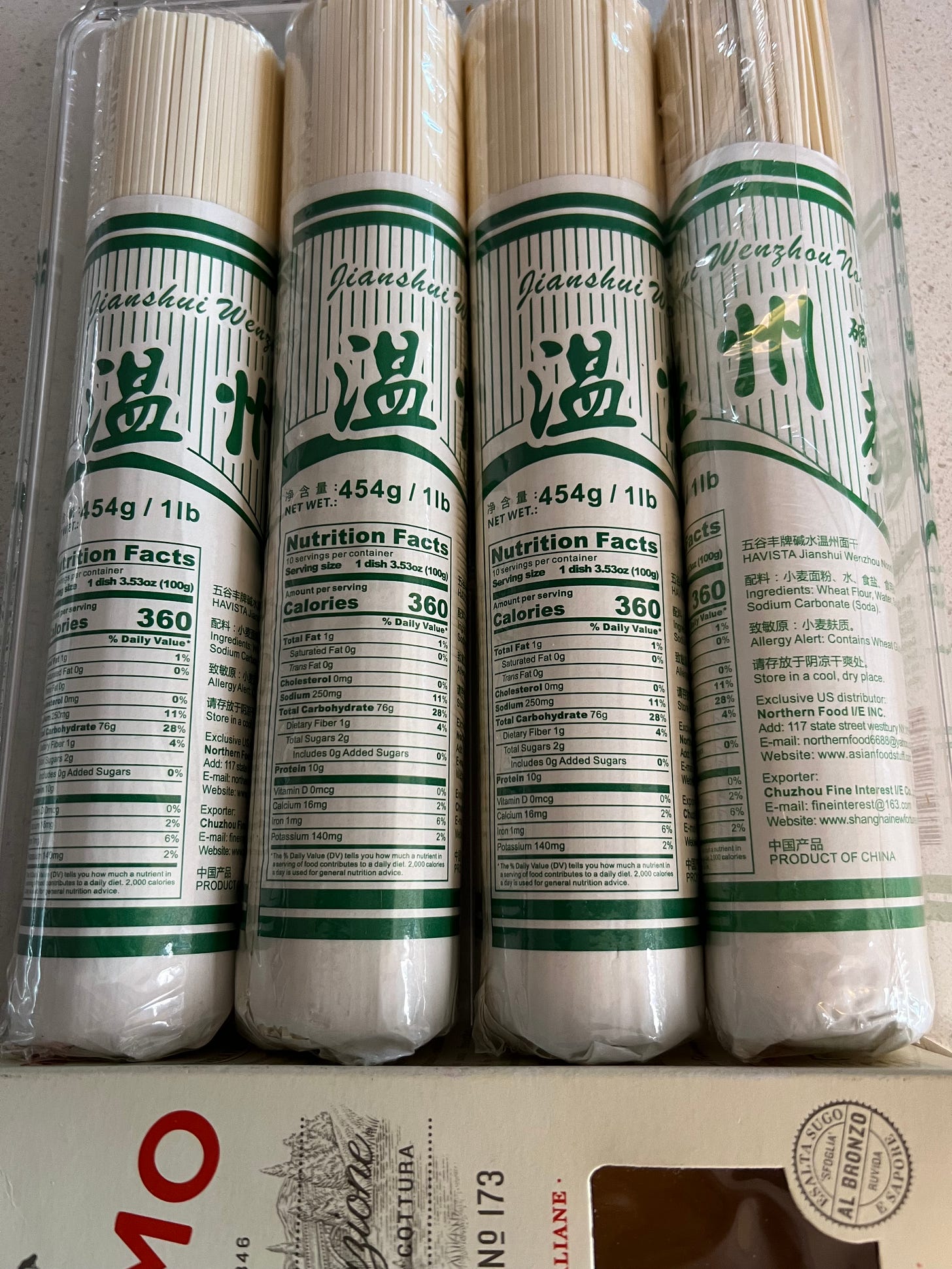Issue #135: Cold Chinese Sesame Noodles
New Year, New Traditions, On Sweetness, Alkaline Noodles, and Sesame Pastes
Happy New Year! Symbolic of a long, happy life, noodles are traditionally eaten at Chinese New Year—which begins late this year on February 10. But why wait? As you know, I love noodles. I eat them all the time. And this weekend, just before the Gregorian New Year, I made a version of cold Chinese sesame noodles for lunch that were so delicious I’m sure they augur a very good 2024.
Although they are considered a staple in Sichuan province, cold sesame noodles are one of those dishes you can find on the menu of just about every Chinese restaurant in New York City and farther afield, no matter which regional Chinese cuisine the restaurant purports to serve. They are largely believed to have been introduced to the United States about 50 years ago by Shorty Tang at his Sichuanese restaurant Hwa Yuan, perhaps the first in New York’s Chinatown. (Read more about that history here.) Like pizza, bad sesame noodles are good and good ones are even better, but great ones are near impossible to find. In my opinion, you have to make them yourself.
I think there are a few key characteristics of great sesame noodles. First, the noodle can’t be too soft or mushy. Ideally, you’ll use a dried alkaline noodle, which you can find in Chinatown, if you hunt a little. Alkaline noodles, that is, noodles made with some sort of alkaline salt added to the wheat dough, are springier and chewier than regular wheat noodles or Italian pasta due to a reaction the salt has on gluten formation. They are the type of noodle used for the best ramen and they are ideal for cold Chinese noodle preparations because they hold their texture when chilled. The ones I’ve bought are flat and square cut, sort of like spaghetti alla chitarra, and they come in cylindrical, one-pound packages. But so do other types of noodles, so you have to read the ingredients on the label carefully to make sure you’ve found the right ones. Look for noodles that contain either sodium carbonate (soda) or potassium carbonate. I pick up a package every time I see them so I always have some in my cupboard. (You can also order them here, though you will pay a lot more than if you find them in an Asian market.) If you can’t find alkaline noodles, use any dried noodle or pasta, but be sure to cook them al dente. Avoid fresh noodles, which can become gummy, unless they are alkaline, which you can sometimes find in Japanese markets for ramen.
Second, the right balance of flavors in the sauce is key. Some sesame noodles are sickeningly sweet. I don’t think sugar is necessary at all, and instead I add a little acidity with rice wine vinegar. But if you prefer your noodles on the sweet side, add a teaspoon of sugar to the sauce. Often sesame noodles taste too much of peanut butter rather than sesame, which is a common, inexpensive way to cheat (though a little peanut butter enhances the sesame flavor and texture of the finished sauce). Unlike tahini from the Middle East, Chinese sesame paste is made from toasted sesame seeds, so it has a darker color and deeper flavor. Tahini doesn’t quite work. (In Israel I have seen tahini made from toasted sesame seeds, which I’m sure you could substitute for the Chinese paste.) Sometimes the name of the sesame paste on the label is translated from the Chinese as “sesame dressing” or “sesame sauce.” Once again, check the ingredients. If the only ingredient is sesame, this is what you are looking for.
As with natural peanut butters, Chinese sesame pastes will throw off a lot of oil that will rise to the top of the jar when stored at room temperature. Use a couple of sturdy chopsticks or a metal spoon to stir the oil back into the paste, and then refrigerate it to prevent it from separating again.

A little chili heat is fundamental to the dish, a not to its Sichuanese origins. For this recipe, I begin by making a kind of quick, à la minute chili oil (i.e., I pour smoking hot oil over aromatics until they sissle). If you have a good, fresh, aromatic chili crisp on hand, you can substitute 2 or 3 tablespoons of that (with sludge) for this concoction, depending on how spicy you like your food. For my oil, I use caiziyou, a traditional Sichuanese cooking oil made from roasted rape seed (the source of canola). It has a particular flavor that permeates so much of the food there. I get it in Chinatown, but you can find it online. I only use it when making Sichuan food. (Note, you are supposed to heat this oil to almost smoking before you use it. Don’t use it raw.) But if you can’t find caiziyou, use a Chinese peanut oil, which has a rich texture and distinct peanut taste.
The texture of the sauce is important, too. Too thin and it doesn’t stick to the noodles and instead puddles on the plate. Too thick and it’s sludgy. The sauce should be creamy and light and coat each noodle without glopping. Because I always want to add more vegetables to our diet, I add a bunch to my sesame noodles, namely daikon radish, cucumber, and carrot, or whatever I have on hand. But you can leave these out and just serve the noodles dressed in the sauce, which is traditional. A sprinkle of roasted black sesame seeds makes a nice garnish.
I suspect most of the cold sesame noodles you find around town are made from one of the many prepared sauces that come in jars. Different from the sesame dressing or sauce mentioned above, which is another name for sesame paste, these are actually dressings you just dump on cooked noodles. I’ve never had a good one. Trust me, once you have the ingredients on hand and you make your own, you’ll realize how easy and how delicious these noodles can be.
Technically, sesame noodles are not the noodles eaten on Chinese New Year, which should be longevity or long-life noodles, made extra long for all the symbolic reason mentioned above. I’ve usually seen e-fu noodles, two-foot long noodles that are deep fried, dried, and then braised, served on Chinese New Year, though apparently there’s a debate about what counts as traditional. (Those are braised e-fu noodles in the video, above.)
But sesame noodles are part of a different New Year’s tradition for me. Every year my local branch of the Taoist Tai Chi Society of the USA—where I practice and teach tai chi and on the national board of which I serve—hosts a New Year’s Day potluck. COVID put a stop to that. But this year we resumed the tradition. To that event, one of the branch’s founding members, Oren Fader, always brings several orders of cold sesame noodles to share. Among a table of delicious treats, they are one of the most popular offerings. Why not make it your tradition to make your own sesame noodles this year?
All the best wishes for a year full of light and enlightenment for all the people and places that need it.
RECIPE: Cold Chinese Sesame Noodles
For the noodles
8 to 10 ounces dried Chinese alkaline noodles or other long pasta
1 teaspoon toasted sesame oil
For the chili oil
1 large clove garlic, peeled
½-inch piece ginger, peeled
1 to 3 teaspoons Korean gochugaru or the spicier roasted Sichuan xiang la la jiao mian (chili powder), depending on your spice tolerance
1 tablespoon sesame seeds
2 scallions, white and green parts, finely chopped
3 tablespoons caiziyou (Sichuan roasted rape seed oil) or Chinese peanut oil
For the dressing
3 tablespoons light soy sauce
1 tablespoon dark soy sauce
2 tablespoons rice wine vinegar
½ teaspoon toasted sesame oil
1 teaspoon sugar (optional)
2 heaping tablespoons Chinese sesame paste
1 heaping tablespoon smooth peanut butter (or additional sesame paste)
1 tablespoon cold black tea, vegetable stock, or water
For the garnish (optional)
3/4 cup julienned daikon
¾ cup julienned cucumber
¾ cup julienned carrot
¼ cup cilantro leaves and chopped stems
1 scallion, sliced thinly on the diagonal
½ teaspoon toasted black or white sesame seeds
Bring a large pot of water to a boil. Add the noodles, stir, and cook just about 5 minutes or so, until they are tender but still have a bit of an al dente bite to their core. Pay attention to the pot, as these noodles are starchy and have a tendency to boil over. Reserve a couple of tablespoons of cooking water for the sauce. Once cooked, drain immediately in a colander and rinse with cold water until cool. Drain well and transfer to a large mixing bowl. Toss the noodles with the teaspoon of sesame oil. Chill while you make the sauce.
Into a small, heatproof bowl, grate the garlic and ginger using a Microplane. Add the gochugaru or other chili powder, sesame seeds, and the finely chopped scallions. In a small frying pan, heat the oil over high until it begins to smoke. Quickly and carefully pour the smoking hot oil into the small bowl with the aromatics so that they sizzle. (Note, you can substitute two or three tablespoons of a good chili crisp for this concoction.)
Add the light soy sauce, dark soy sauce, rice wine vinegar, toasted sesame oil, sugar (if using), sesame paste, peanut butter and tea, and using a small whisk, blend the ingredients until the sesame paste and peanut butter have dissolved. Add a splash or two of the reserved hot noodle cooking water to help break down the pastes.
Retrieve the noodles from the refrigerator. If using the vegetable garnish, add about 2/3 of each and all but a pinch of cilantro to the bowl with the noodles. Stir the dressing and add it to the bowl. Use tongs to toss the noodles well so that everything is coated with the sauce. Transfer to a serving bowl or platter, scraping the bowl clean with a rubber spatula, and garnish with the remaining vegetables and cilantro, if using, the diagonally cut scallion, and the toasted sesame seeds.





